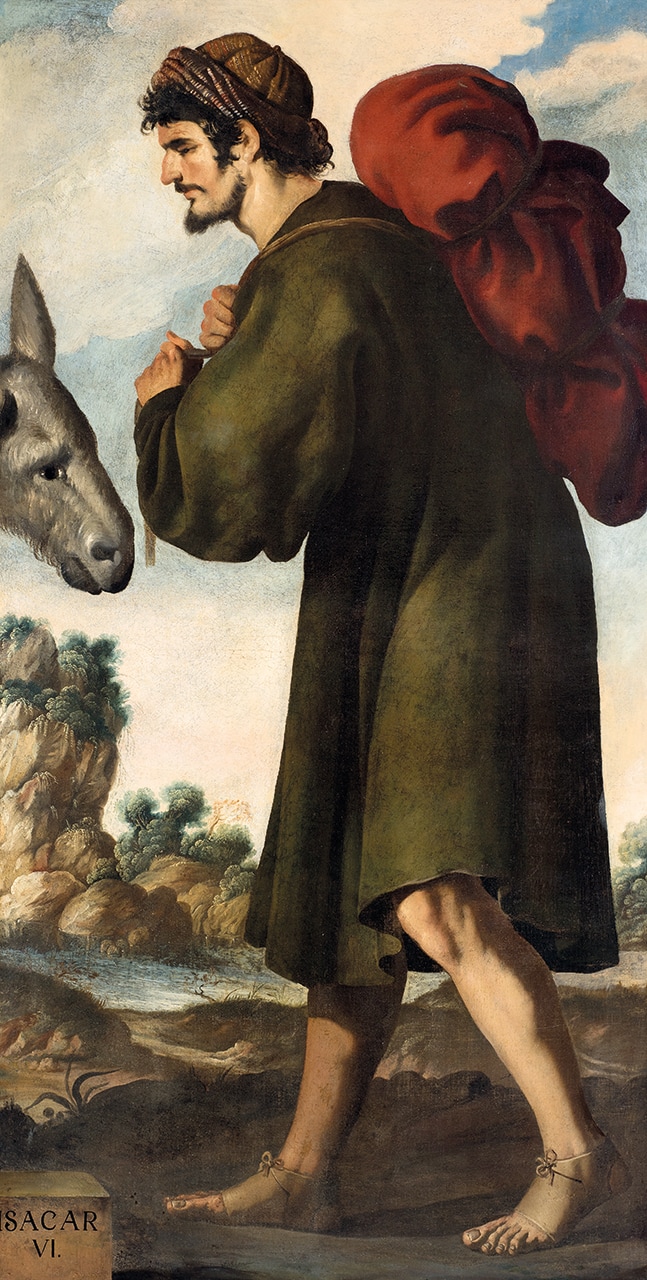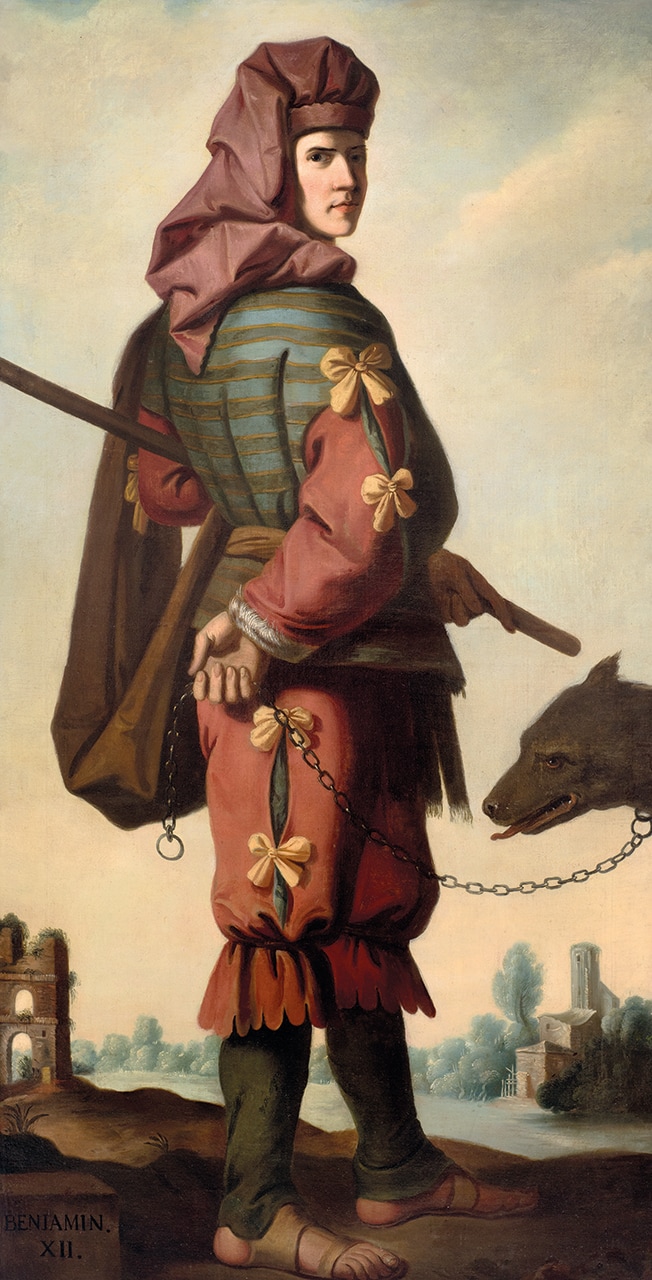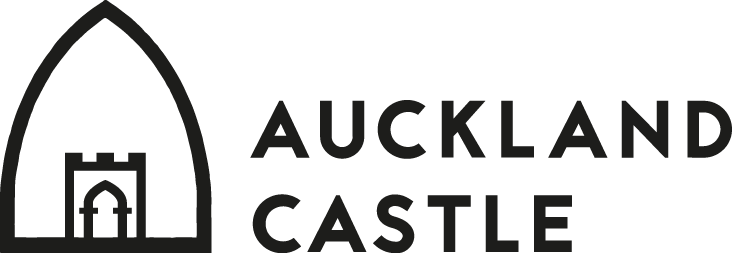

Issachar & Benjamin
Issachar and Benjamin form part of a series of thirteen portraits of Jacob and his sons, the forefathers of the Twelve Tribes of Israel. The depiction of the former reflects on the description of him as a ‘strong ass’ who will be destined to work the land as the servant of others (Genesis 49:14–15). The simplicity of his garments differentiates him from his brothers, who are depicted in a more elaborate fashion. The only note of colour is the bundle on his back, which emphasizes the prospect of physical toil. His companion on the road is an ass or donkey, which serves both as a literal object and as a symbolic reference to his characterization as a beast of burden. Its naturally sorrowful look adds a note of pathos and compassion, while the arduous terrain in the background, consisting of rocky outcrops and uneven riverside paths, appears to pit the strength of Issachar against that of nature itself.
Benjamin, the youngest and most beloved son of Jacob, is portrayed as a youthful, clean-shaven figure in a pastoral landscape with architectural ruins in the background. With his body twisted as he looks over his right shoulder, he is seen as if walking away from the viewer, a pose that increases the vivacity of the image. His handsome dress is decorated with bows, and he sports a multicoloured outer garment, similar to the striped trousers in the painting of his brother Zebulun. The bag on his shoulder alludes to the tale of his brother, Joseph, who hid a silver cup in his sack, which he then used as a pretext for keeping him hostage in Egypt until his brothers returned with their father (Genesis 44:1–17). Benjamin is accompanied by a panting wolf on a chain, which, as is the case with Issachar’s donkey, serves both as a literal reference and as an allusion to the words of his father in characterizing him as ‘a ravenous wolf; in the morning he devours the prey, in the evening he divides the plunder’ (Genesis 49:27).
When the series of Zurbarán’s Jacob and his Twelve Sons came up for auction in 1756 Richard Trevor, the Prince Bishop of Durham, tasked his London agent with the responsibility acquiring the set. Unfortunately, he was outbid for Benjamin, which subsequently entered the collection of Grimsthorpe Castle near Peterborough. He therefore commissioned the British artist, Arthur Pond (1701–98), to produce a faithful copy, which cost almost as much as the most expensive of Zurbarán’s originals. It has been displayed alongside them ever since.
 Click to zoom and pan
Click to zoom and pan
 Click to zoom and pan
Click to zoom and pan
...
Your feedback is very important to us. Would you like to tell us why?
We will never display your feedback on site - this information is used for research purposes.
Artwork Details
Title
Issachar.
Artist
Francisco de Zurbarán (Fuente de Cantos, Badajoz, c. 1598 – Madrid, 1664).
Date
c. 1640–45.
Medium and Support
Oil on canvas.
Dimensions
200 x 103.5 cm.
Marks and Inscriptions
‘Isacar VI’ inscribed on stone at bottom left.
Acquisition Details
Acquired by the Auckland Castle Trust and the Zurbarán Trust from the Church Commissioners, 2011.
Previous Owners
Sir William Chapman (c. 1670–1737); his sale, London c. 1722, part of lots 41–52; where acquired by James Mendez (–1756); his posthumous sale, Langford, London, 25–26 February 1756, lot 30; where acquired by Richard Trevor, Bishop of Durham (1707–71); and thereafter to the Bishops of Durham.
Institution
Auckland Castle, Bishop Auckland.
Title
Benjamin, after Francisco de Zurbarán.
Artist
Arthur Pond (1705–58).
Date
1756.
Medium and Support
Oil on canvas.
Dimensions
197 x 101.5 cm.
Marks and Inscriptions
‘Benjamin XII’ inscribed on stone plinth at bottom left.
Acquisition Details
Acquired by the Auckland Castle Trust and The Zurbarán Trust from the Church Commissioners, 2011.
Previous Owners
Richard Trevor, Bishop of Durham (1707–71); and thereafter to the Bishops of Durham.
Institution
Auckland Castle, Bishop Auckland.
Bibliography
Odile Delenda, Francisco de Zurbarán, 1598–1664: catálogo razonado y crítico, 2 vols (Madrid: Fundación Arte Hispánico & Wildenstein Institute, 2009), pp. 506–23;
Clare Baron & Andy Beresford,‘Zurbarán’s Jacob and his Twelve Sons’, in Spanish Art in County Durham, ed. Clare Baron & Andy Beresford (Bishop Auckland: Auckland Castle Trust, The Bowes Museum, & Durham University, 2014), pp. 26–43;
Susan Grace Galassi Edward Payne, & Mark. A. Roglán, ed., Zurbarán, Jacob and his Twelve Sons: Paintings from Auckland Castle (Madrid: Centro de Estudios Europa Hispánica, 2017).
